selected research
Donation behavior
Consumers’ engagement in WOM is increasingly important for organizations to understand and leverage as a means of promoting future donations and awareness. Prior literature, however, has been limited in what type of information donors share after donating. Some charitable organizations (e.g., the United Way) encourage donors to share about their donations with others; other organizations (e.g., The ALS Association) prompt donors to share about the organization itself. Across ten studies, we demonstrate that donors are more likely to talk about an organization than about their own donation. This effect is driven by persuasion efficacy and is moderated by activated motives, perspective (first or third), magnitude of donation and the decision context. In addition, the current work demonstrates that WOM type influences future donations. The current research addresses recent calls for a better understanding of what consumers choose to talk about, as well as the key drivers of these choices.
RECENTLY PUBLISHED IN THE JOURNAL OF MARKETING RESEARCH.
Visual Perception
Restaurant-to-consumer food delivery has experienced disruption with the growth of third-party services such as DoorDash and Uber Eats. However, this platform-to-consumer delivery method introduces increased opportunities for food tampering and contamination due to additional touchpoints in the delivery process. To mitigate these concerns, more restaurants are implementing tamper-evident closures such as seals attached to the food containers used for delivery items. Drawing on signaling theory, we examine the effect of tamper-evident closures in the third-party delivery context through two experimental studies and a focus group. Our results revealed a negative effect of tamper-evident seals on willingness to pay through lowered food quality evaluations, suggesting the seal sends contamination signals rather than the intended message of food safety. This negative effect appears robust for both food and beverages. We also demonstrate that consumers’ food safety risk perception (FSRP) acts as a boundary condition, attenuating the negative indirect effect for high-FSRP consumers.
RECENTLY PUBLISHED IN THE INTERNATIONAL JOURNAL OF HOSPITALITY MANAGEMENT.
For a complete list of my current research in progress, please download my CV.

